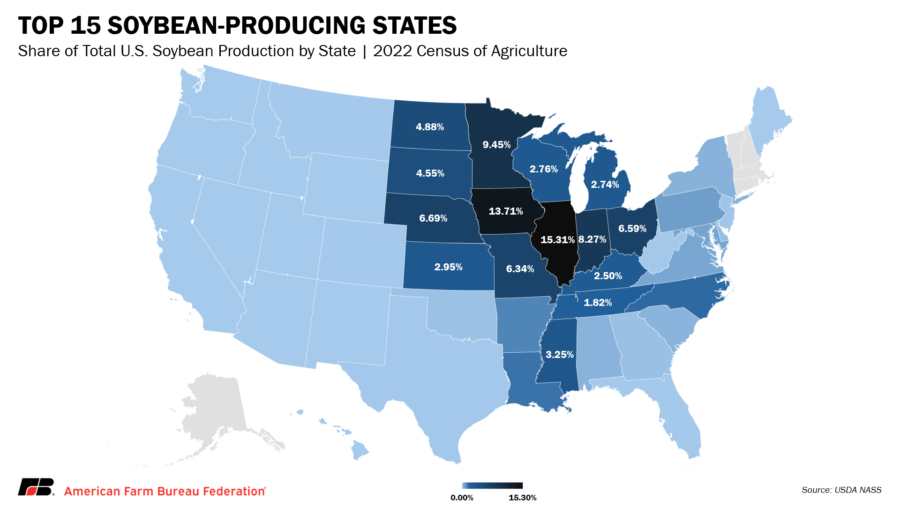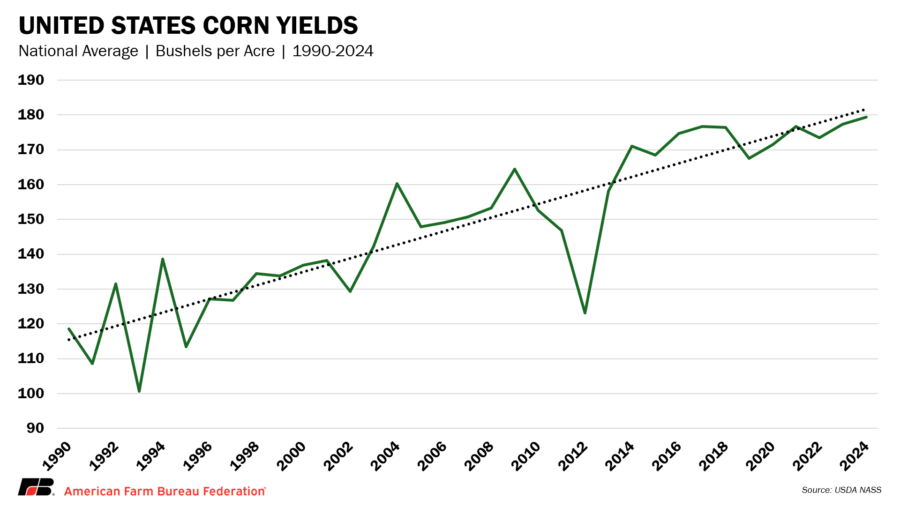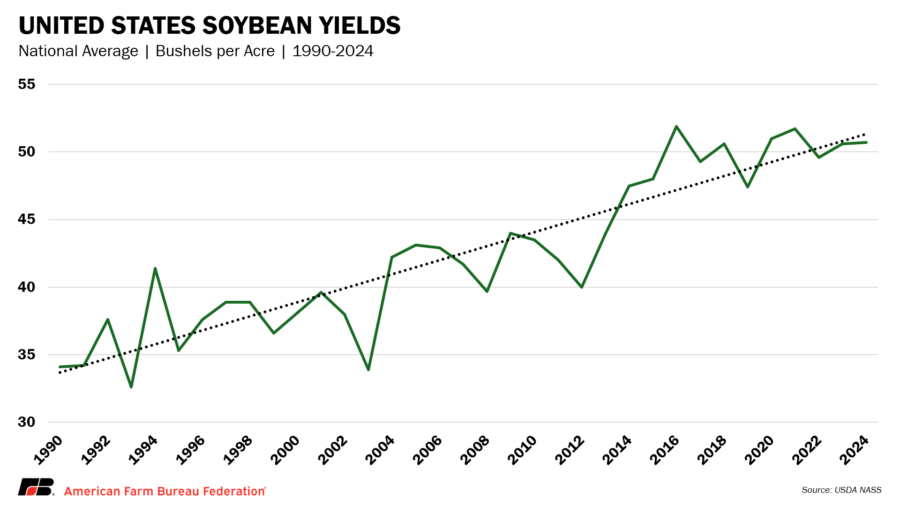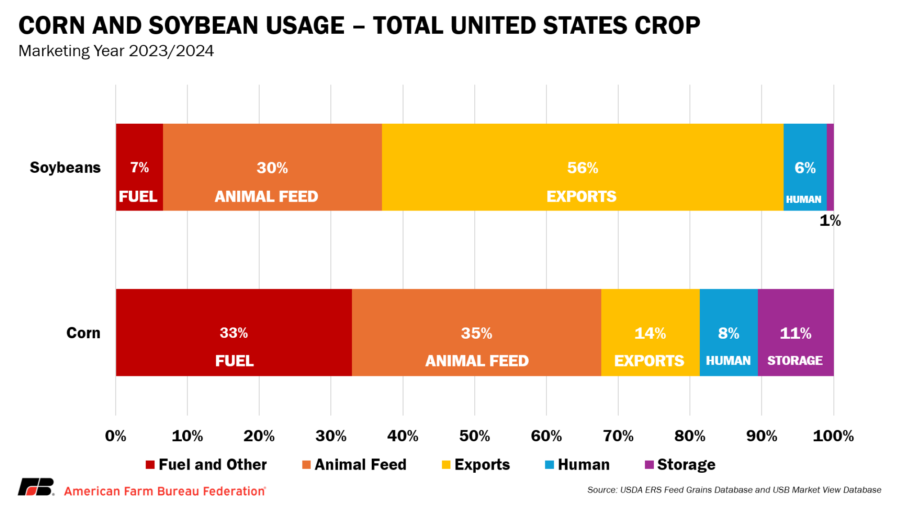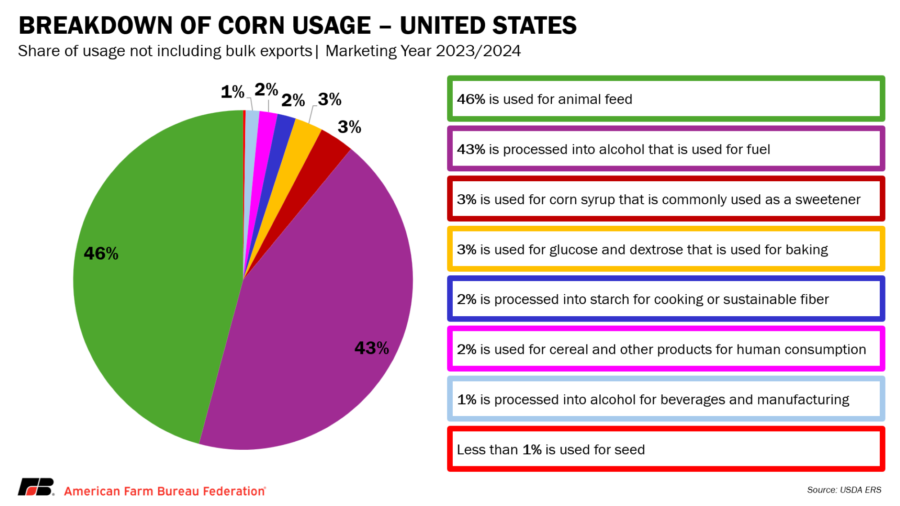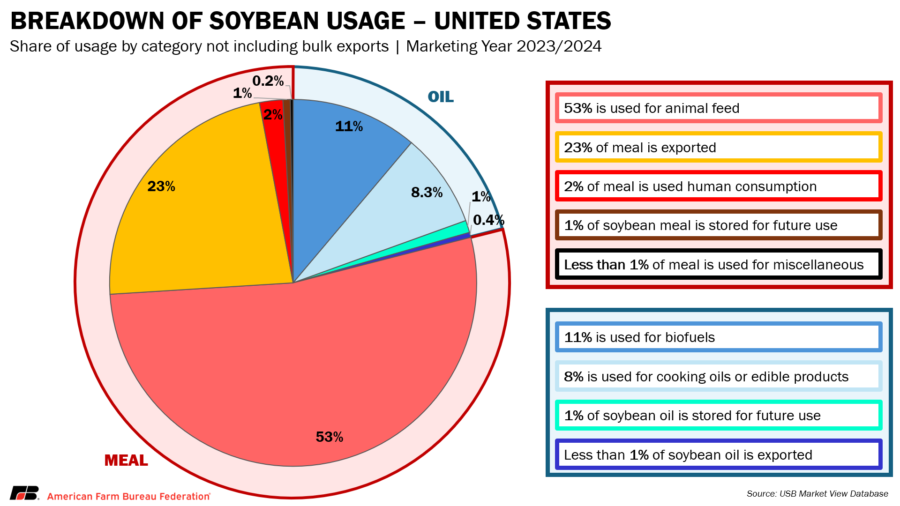Crops Feed Livestock, Power Exports, Fuel the Economy
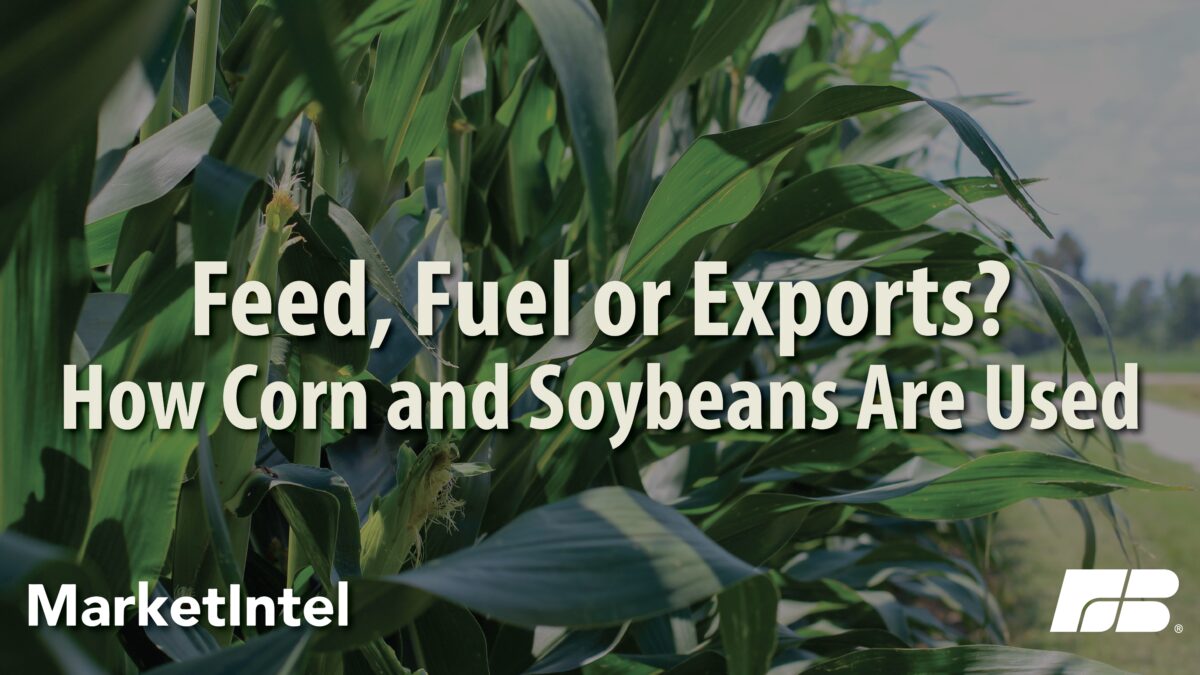
Faith Parum, Ph.D.
Economist
Corn and soybeans may not often appear directly on your dinner plate, but they’re behind much of what does. From feeding the livestock that produce our eggs, meat and dairy to fueling global trade and renewable energy, these crops are foundational to sustaining American lifestyles. Despite common assumptions, only a small portion of row crop productions goes into direct-to-consumer processed foods. Understanding where these crops end up is key to recognizing the vital role America’s farmers play in feeding families at home and around the world.
While some assume U.S. farmers primarily grow crops destined for processed food products, corn and soybeans are mostly used to support livestock feed, fuel and global trade — economic drivers that deliver measurable value. The broader agricultural sector, covering farming, processing, distribution and retail, contributed over $1.5 trillion to U.S. gross domestic (GDP) product in 2023, representing roughly 5.5 % of the national economy. Crop and livestock commodity production alone contributed $222 billion in value-added products. Additionally, the agriculture sector directly supported over 22 million jobs in 2022, despite only about 2 million people working directly on farms.
Clarifying how U.S. crops are used supports more informed discussions on food policy, rural economic development and energy resilience.
Corn and Soybean Production at a Glance
In 2023, U.S. corn production was over 15.3 billion bushels, harvested from around 86.5 million acres, at an average yield of 177 bushels per acre. For the same year, soybean output reached 4.16 billion bushels across approximately 82 million acres, yielding about 50.6 bushels per acre. Many farmers rotate between corn and soybeans from year to year, so acreage can shift depending on market conditions, weather and other factors.
Corn and soybeans represent the second- and third-highest valued crop commodities in the U.S., following only cattle and calves in total agricultural cash receipts. The United States is also the world’s largest producer and exporter of corn and one of the top producers and exporters of soybeans, making these crops central to both domestic agriculture and global food and feed supply chains.
Production of both crops is centered in the Midwest. Iowa and Illinois lead acreage for corn, followed by Minnesota, Nebraska and Indiana. Together, these states produce over 60% of the U.S. corn volume. Soybean output is similarly dominated by Illinois and Iowa, with Minnesota, Indiana and Nebraska rounding out the top five. Together, these states produce nearly half of U.S. soybean volume.
Additionally, U.S. farmers grow corn and soybeans with exceptional scale and cost efficiency compared to historical benchmarks. Since 1990, average corn yields have increased by more than 50%, rising from 118.5 to 179.3 bushels per acre. Soybean yields have grown by nearly 49%, from 34.1 to 50.7 bushels per acre. These gains are the result of continued improvements in mechanization, seed genetics and precision agriculture. By producing more with fewer resources like land and water, farmers help ensure a steady and affordable supply of crops for feed, fuel and export markets. Without these yield gains, over 80 million more acres would be needed to grow the same amount of corn and soybeans produced today.
Where Do the Crops Go? Breaking Down Usage
The vast majority of corn is not consumed directly by people. USDA data shows around 35% of corn goes to animal feed and residual use, which includes small or untracked uses like seed, on-farm consumption, storage losses or other miscellaneous uses. Approximately 33% is used in ethanol, whose co-products (e.g., dried distillers grains) are often returned to livestock rations. Fourteen percent is exported, 8% is processed into food and industrial goods, and 11% is stored for future use.
It’s important to note that these figures refer to field corn, not sweet corn. Sweet corn, the kind eaten fresh, canned or frozen, accounts for less than 1% of total corn acreage and is typically categorized with other specialty crops. Field corn, by contrast, is harvested dry and starchy, making it well-suited for feeding livestock, fueling cars and supporting a wide range of other uses.
Soybeans follow a similar distribution. Of total soybean output, 30% goes to livestock feed via meal, 7% is dedicated to renewable fuel production, 1% is stored and 56% enters export markets as meal and oil. Only a minimal share is used directly in processed foods. In the United States, over 50% of soybean production is crushed. Of the soybeans crushed, 80% becomes meal and 20% becomes oil.
The figures below illustrate how most corn and soybeans are used in the United States: in feed and renewable energy, and as exports, rather than in packaged food ingredients.
Context on Food Manufacturing Use
Some corn- and soy-based ingredients such as sweeteners, starches and oils are used in packaged foods. By contrast, the overwhelming majority of corn and soybeans serve as raw materials for livestock feed, biofuels and global markets. That distinction is important when discussing the economics of agriculture and farmer decision-making.
The Feed Behind the Food
Corn and soybean meal are central to rations for beef and dairy cattle, chickens, turkeys, pigs and other livestock, often accounting for up to 70% of livestock production costs. Corn supplies energy, while soybean meal delivers protein, together enabling efficient animal growth while keeping consumer prices stable. According to the National Institutes of Health, Americans receive close to 70% of their protein from animal sources including poultry (16%), dairy (14%), red meats (12%), seafood (6%), cured meats (8%) and eggs (6%). These protein-rich foods are staples of the American diet and their availability depends heavily on reliable corn and soybean production. Even aquaculture operations rely on corn- and soy-based feeds. USDA data also shows that about 90% of Americans fall short of recommended dairy intake, further underscoring the importance of maintaining a stable supply of quality livestock feed.
A single bushel of corn can generate several pounds of chicken or pork, depending on an animal’s feed conversion efficiency. This highlights how crop output is multiplied in the supply chain, from farm to feed to meat, delivering downstream value across segments. As global incomes rise and developing economies demand more animal-sourced nutrition, U.S. farmers are well-positioned to meet growing need for animal proteins with a robust and efficient feed and livestock production system.
Trade and Export Value
In 2023, U.S. agricultural exports generated $175.5 billion in export value and supported an additional $186.9 billion in economic impact across related industries. That total export-driven output reached $362.4 billion, reflecting a multiplier of about $2.06 in economic activity for every dollar exported.
Bulk exports of corn and soybeans accounted for $40.7 billion of this total, generating another $35.9 billion in downstream economic activity. Nonbulk exports (such as soybean meal, ethanol) and processed agriculture goods contributed $101.3 billion in exports and supported $120.7 billion of further economic output.
By tapping global demand for feed and food, farmers boost farm income, strengthen rural economies and reinforce U.S. competitiveness in overseas markets.
Economic Role of Corn and Soybeans
According to the National Corn Growers Association, corn farming generated approximately $151 billion in total economic output in 2023, directly contributing $62 billion to U.S. GDP. The industry supported over 524 sectors of the economy and provided $35 billion in labor income across farming, transportation, processing and manufacturing sectors.
Soybeans also play a major economic role. In 2023, soybean production contributed more than $124 billion in total economic output and supported over 500,000 jobs across farming, input supply, processing and export channels. The soybean value chain is closely linked to both the domestic livestock sector and global markets.
Together, corn and soybeans form the economic backbone of American crop production as it is globally traded, financially essential and foundational to rural prosperity and several aspects of each dinner plate.
Conclusion
Corn and soy are far more than ingredients for processed snacks and have far-reaching economic impact. These crops feed livestock, power global exports and contribute billions to the U.S. economy. Agriculture and food-related industries generate $1.5 trillion in GDP and support 22 million American jobs, many of them directly tied to crop production, and all that goes into getting those crops to their final destination, often in a new form.
Farmers are not just growing commodities. They produce essential inputs for an interconnected and modern agricultural system that delivers affordable meat, dairy and eggs to grocery shelves, renewable fuels that power our vehicles and thousands of everyday goods found in American homes. Their work sustains not only rural communities, but also the meals, jobs and economic stability that every American relies on every day.
Top Issues
VIEW ALL
